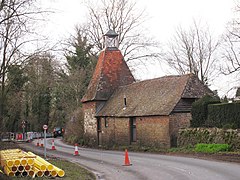Headley, East Hampshire
| Headley | |
|---|---|
 Oast House at Wey House, Standford Lane, Headley | |
 Headley Location within Hampshire | |
| Population | 5,613 (2011 Census)[1] |
| OS grid reference | SU821362 |
| Civil parish |
|
| District | |
| Shire county | |
| Region | |
| Country | England |
| Sovereign state | United Kingdom |
| Post town | Bordon |
| Postcode district | GU35 |
| Dialling code | 01428 |
| Police | Hampshire |
| Fire | Hampshire |
| Ambulance | South Central |
| UK Parliament | |
Headley is a village and civil parish in the East Hampshire district of Hampshire, England. It is 1.8 miles (2.9 km) east of Bordon on the B3002 road.
The nearest railway station is 3.6 miles (5.8 km) south of the village at Liphook.
The civil parish of Headley has a population of over 5,500. The parish comprises a number of settlements as well as the village of Headley itself: Standford, Arford, Headley Down, Barford, Wishanger, Sleaford, Trottsford, and part of Hollywater. Its area is 4,862 acres (19.68 km2). The original parish included Grayshott (until 1902), Lindford, and a considerable portion of Bordon (until 1929). The ecclesiastical parish of All Saints, Headley served Lindford and Bordon, although not Grayshott, until March 2002 — since then Bordon has become a separate ecclesiastical parish.
History[]
Headley is the oldest of three villages in the south of England of that name and has gone through a number of name spellings, but was first noted (no households were recorded) in the Domesday Book of 1086, at which time Eustace II, Count of Boulogne was tenant-in-chief and Lord. In 1066, Earl Godwin held it.[2]
Amenities[]
All Saints Anglican Church is in the centre of the village, and is in the Diocese of Guildford. The church predates 1836 when the wooden-shingled spire burnt down. The church was subsequently rebuilt (without the spire) in 1859.[3] Features in the rebuilt church date its existence back at least to the 13th century.[4] Nikolaus Pevsner noted that the oblong piece of 13th century stained glass of a female saint being decapitated was ”exquisite”.[5]
Headley Cricket Club is to the west of the village centre, their grounds also accommodating bowls and soccer clubs. Headley CC play in the I'Anson league (2015) and have 3 senior teams, as well as youth teams.
The Holly Bush is a public house in the centre of the village. It dates from the 19th century. Its predecessor of the same name is believed to have been on the other side of the road when William Cobbett (Rural Rides) visited Headley in 1822.[6]
Headley Theatre Club was founded in 1952, building on the success of a pageant held to celebrate the Festival of Britain the previous year. It was felt that an organisation should be formed in the Village to encourage such enthusiasm and talent on a more permanent basis. The Club puts on a pantomime, a 3-act play and a musical event each year.[7]
Notable inhabitants[]
- Lord King-Hall of Headley - journalist, playwright and politician.
- Sir Robert Samuel Wright - British judge and author.
Properties[]
- Headley Grange was used as a recording studio by several famous pop groups in the 1970s including: Genesis, Bad Company, Pretty Things, Ian Dury (1976) and Clover (1977) – notably in 1971 Led Zeppelin recorded their fourth album there, Led Zeppelin IV, containing Stairway to Heaven.[8]
- Benifold, in Headley Hill Road, was bought by the group Fleetwood Mac in 1970 and used to record their Penguin and Mystery to Me albums with the Rolling Stones Mobile Studio, having recorded Future Games at Advision Studios in London and Bare Trees at De Lane Lea Studios in the London district of Wembley. They sold the property around 1974 after permanently relocating to Los Angeles, California.
References[]
- ^ "Civil Parish population 2011". Neighbourhood Statistics. Office for National Statistics. Retrieved 19 December 2016.
- ^ "Open Domesday: Headley, Hampshire". Retrieved 30 June 2020.
- ^ "Hantsphere heritage in place: All Saints' Church, Headley". Retrieved 11 October 2013.[permanent dead link]
- ^ "All Saints', Headley". Retrieved 11 October 2013.
- ^ Pevsner and Lloyd. The Buildings of England: Hampshire and the Isle of Wight. Penguin. p. 286. ISBN 0140710329.
- ^ Smith, John Owen (2002). One Monday in November and beyond: The Selbourne and Headley workhouse riots of 1830. ISBN 1873855338.
- ^ "Headley Theatre Club". Retrieved 1 October 2013.
- ^ "History of Headley Grange". Retrieved 22 August 2021.
External links[]
| Wikimedia Commons has media related to Headley. |
- Headley Village web site
- "Headley's Past in Pictures". Hantsphere. Hampshire County Council. Archived from the original on 25 July 2011. Retrieved 21 February 2008.
- British History Online: Headley
- Historical information on GENUKI
- Headley history
- Headley Village Hall
- Headley Society
- Canadians in Headley during WW2
- Historical links and publications about Headley
- Villages in Hampshire
- Civil parishes in Hampshire
- East Hampshire District

